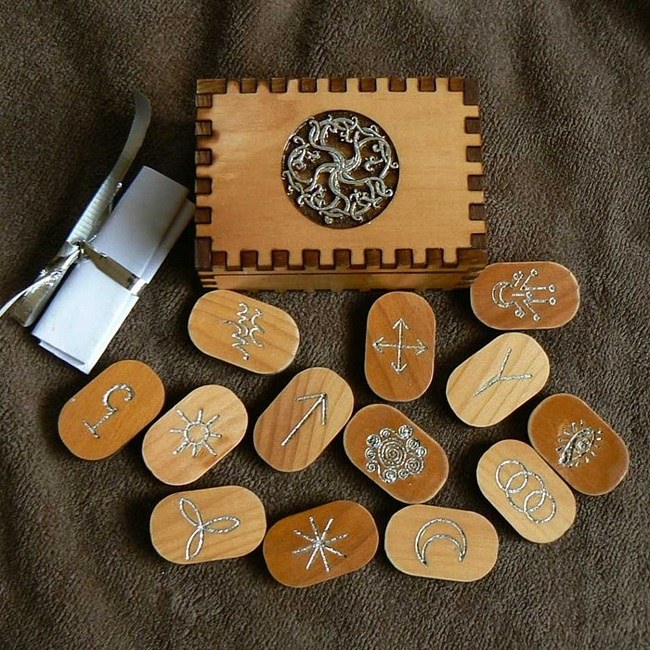The runes are the Norse alphabet. The Normans pre-Christian era knew neither parchment nor paper. The writing was applied to wood, stone, metal objects, then said not to "write" and "cut the runes". Linked to this is the angular form of the runes – marks composed of straight lines located at different angles.
With the birth of writing, the idea of conservation of information is not in the form of drawings depicting concrete images and signs that transmit abstract concepts, excitement, mixed with fear. It seemed like witchcraft – every written word seemed a spell. So, writing "turned into" magic signs emerged runic magic.
Runic inscriptions on the sacred stones, weapons, and other artifacts of the Viking age is an important part of Norse history and culture. Against their study as opposed to any scientific research in the field of history or cultural studies, the Orthodox Church did not mind never. Objections arise when modern people begin to perceive the runes just as the ancient Norsemen – their magical aspect, and do it even those who consider themselves Christians.
Some runes directly relate to the gods of the Norse Pantheon: Ansuz – Odin, Inguz – Freerom, Teyvaz – Turom. The use of such runes (e.g. mascots) actually means the worship of pagan gods. The Christian doesn't have to do this fundamentally, this is a direct violation of the commandment enjoining the worship of only one God: "Yes, no will you have other gods..."
The Church rejects the very idea of magic. It clearly stated in the old Testament: "do Not nothing guess... And if the soul turn to mediums and wizards, I will pay the person at the soul and destroy it from the people". Not repealed this prohibition in the New Testament: the revelation of John the theologian in the number of those who no road to the heavenly city, along with the "sexually immoral and murderers" called sorcerers.
Magic is an attempt to control the invisible world of spirits. Angels to control man cannot, in principle, they obey only God – hence, the MAG remains only to control the demons, or rather, to think that he can manage them. To put themselves at the service of the forces of evil is unacceptable for a Christian. In addition, this attempt to transcend the limits of natural possibilities is a manifestation of pride – the greatest sin that creates all others.
There is nothing good in divination, and runic. Wanting to know your future, exhibiting a distrust of God, to His will, and the faith is no longer the question. Besides, during the runic divination appealing to standards – pagan goddesses of fate.
The risk of rune magic was obvious even to the Norse pagans. In the sagas we can find examples of the negative consequences of the reckless use of runes. In this light, it becomes clear the words of the "Elder Edda": "Here is what I will answer when asking the runes are divine... good in silence". None of the Icelander or Norwegian of the era not drew even in the air rune symbol, the value of which bad imagined. Modern people often wear talismans with the image of the runes, about which I know nothing. This attitude towards runes can not withstand scrutiny not only from the perspective of the Orthodox Church, but also from the point of view of the Scandinavian mythological tradition.
With the birth of writing, the idea of conservation of information is not in the form of drawings depicting concrete images and signs that transmit abstract concepts, excitement, mixed with fear. It seemed like witchcraft – every written word seemed a spell. So, writing "turned into" magic signs emerged runic magic.
Runes as pagan tradition
Runic inscriptions on the sacred stones, weapons, and other artifacts of the Viking age is an important part of Norse history and culture. Against their study as opposed to any scientific research in the field of history or cultural studies, the Orthodox Church did not mind never. Objections arise when modern people begin to perceive the runes just as the ancient Norsemen – their magical aspect, and do it even those who consider themselves Christians.
Some runes directly relate to the gods of the Norse Pantheon: Ansuz – Odin, Inguz – Freerom, Teyvaz – Turom. The use of such runes (e.g. mascots) actually means the worship of pagan gods. The Christian doesn't have to do this fundamentally, this is a direct violation of the commandment enjoining the worship of only one God: "Yes, no will you have other gods..."
The magical essence of the runes
The Church rejects the very idea of magic. It clearly stated in the old Testament: "do Not nothing guess... And if the soul turn to mediums and wizards, I will pay the person at the soul and destroy it from the people". Not repealed this prohibition in the New Testament: the revelation of John the theologian in the number of those who no road to the heavenly city, along with the "sexually immoral and murderers" called sorcerers.
Magic is an attempt to control the invisible world of spirits. Angels to control man cannot, in principle, they obey only God – hence, the MAG remains only to control the demons, or rather, to think that he can manage them. To put themselves at the service of the forces of evil is unacceptable for a Christian. In addition, this attempt to transcend the limits of natural possibilities is a manifestation of pride – the greatest sin that creates all others.
There is nothing good in divination, and runic. Wanting to know your future, exhibiting a distrust of God, to His will, and the faith is no longer the question. Besides, during the runic divination appealing to standards – pagan goddesses of fate.
The risk of rune magic was obvious even to the Norse pagans. In the sagas we can find examples of the negative consequences of the reckless use of runes. In this light, it becomes clear the words of the "Elder Edda": "Here is what I will answer when asking the runes are divine... good in silence". None of the Icelander or Norwegian of the era not drew even in the air rune symbol, the value of which bad imagined. Modern people often wear talismans with the image of the runes, about which I know nothing. This attitude towards runes can not withstand scrutiny not only from the perspective of the Orthodox Church, but also from the point of view of the Scandinavian mythological tradition.

